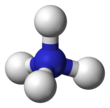Script assisted update of identifiers from ChemSpider, CommonChemistry and FDA for the Chem/Drugbox validation project - Updated: {{cascite}} StdInChI StdInChIKey. |
Updating {{chembox}} (no changed fields - added verified revid - updated 'StdInChI_Ref', 'StdInChIKey_Ref') per Chem/Drugbox validation (report errors or |
||
| Line 1: | Line 1: | ||
{{main|Ammonia}} |
{{main|Ammonia}} |
||
{{Chembox |
{{Chembox |
||
| verifiedrevid = |
| verifiedrevid = 399518453 |
||
| Name = Ammonium hydroxide |
| Name = Ammonium hydroxide |
||
| ImageFileL1 = Ammonia-3D-balls.png |
| ImageFileL1 = Ammonia-3D-balls.png |
||
| Line 17: | Line 17: | ||
| OtherNames = |
| OtherNames = |
||
| Section1 = {{Chembox Identifiers |
| Section1 = {{Chembox Identifiers |
||
| StdInChI_Ref = {{stdinchicite|correct|chemspider}} |
|||
| |
| StdInChI = 1S/H3N.H2O/h1H3;1H2 |
||
| StdInChIKey_Ref = {{stdinchicite|correct|chemspider}} |
|||
| StdInChIKey = VHUUQVKOLVNVRT-UHFFFAOYSA-N |
| StdInChIKey = VHUUQVKOLVNVRT-UHFFFAOYSA-N |
||
| CASNo_Ref = {{cascite|correct|CAS}} |
| CASNo_Ref = {{cascite|correct|CAS}} |
||
Revision as of 14:11, 29 November 2010
| |||
| |||

| |||
| Identifiers | |||
|---|---|---|---|
3D model (JSmol)
|
|||
| ChemSpider | |||
| ECHA InfoCard | 100.014.225 | ||
| E number | E527 (acidity regulators, ...) | ||
| UNII | |||
CompTox Dashboard (EPA)
|
|||
| |||
| |||
| Properties | |||
| NH4OH | |||
| Molar mass | 35.04 g/mol | ||
| Appearance | very volatile solution, colorless, bitter smell | ||
| Density | 0.91 g/cm3 (25 %) 0.88 g/cm3 (32 %) | ||
| Melting point | −57.5 °C (25%) −91.5 °C (32%) | ||
| Boiling point | 37.7 °C (25%) 24.7 °C (32%) | ||
| Miscible | |||
| Related compounds | |||
Other anions
|
Ammonium chloride Ammonium cyanide | ||
Other cations
|
Tetramethylammonium hydroxide | ||
Except where otherwise noted, data are given for materials in their standard state (at 25 °C [77 °F], 100 kPa).
| |||
Ammonium hydroxide, also known as ammonia water, ammonical liquor, ammonia liquor, aqua ammonia, aqueous ammonia, or simply ammonia, is a solution of ammonia in water. It can be denoted by the symbols NH3(aq). Although its name suggests a base with composition [NH4+][OH−], it is not actually possible to isolate samples of NH4OH — it exists only in dilute aqueous solutions.[2]
Basicity of ammonia in water
In aqueous solution, ammonia deprotonates a small fraction of the water to give ammonium and hydroxide according to the following equilibrium:
- NH3 + H2O ⇌ NH4+ + OH−.
In a 1M ammonia solution, about 0.42% of the ammonia is converted to ammonium, equivalent to a pH of 11.63. The base ionization constant is
- Kb = [NH4+][OH-]/[NH3] = 1.8×10−5
Saturated solutions
Like other gases, ammonia exhibits decreasing solubility in solvent liquids as the temperature of the solvent increases. "Ammonium hydroxide" solutions decrease in density as the concentration of dissolved ammonia increases. At 15.6 °C (60.1 °F), the density of a saturated solution is 0.88 g/ml and contains 35% ammonia by mass, 308 g/l w/v, (308 grams of ammonia per litre of solution) and has a molarity of approximately 18 mol L−1. At higher temperatures, the molarity of the saturated solution decreases and the density increases.
When solutions that are saturated at cold temperatures are sealed in containers and subsequently warmed, the concentration of the solution decreases and the vapor pressure of ammonia gas increases. Unsealing such containers can lead to a burst of ammonia gas. In extreme cases, the containers could rupture.
From a chemist's perspective, one should be aware that the concentration of a saturated solution is continually dropping as the container is handled in a warmer environment. Thus, old samples of ammonium hydroxide will deviate from 18 M, as can be verified by titration.
Applications
Household ammonia is dilute ammonium hydroxide, which is also an ingredient of numerous other cleaning agents, including many window cleaning formulas. In addition to use as an ingredient in cleansers with other cleansing ingredients, ammonium hydroxide in water is also sold as a cleaning agent by itself, usually labelled as simply "ammonia". It may be sold plain, lemon-scented (and typically colored yellow), or pine-scented (green).
In industry, ammonium hydroxide is used as a precursor to some alkyl amines, although anhydrous ammonia is usually preferred. Hexamethylenetetramine forms readily from aqueous ammonia and formaldehyde. Ethylenediamine forms from 1,2-dichloroethane and aqueous ammonia.[3]
In furniture-making, ammonium hydroxide was traditionally used to darken or stain wood containing tannic acid. Tannic acid with ammonium hydroxide or iron salts creates a brown stain which can be applied to wood. [4]
Ammonium hydroxide is used in the meat packing industry. Some companies treat their beef "with a pH enhancement process that forms ammonium hydroxide in the finished product."
Laboratory use
Aqueous ammonia is used in traditional qualitative inorganic analysis as a complexant and base. Like many amines, it gives a deep blue coloration with copper(II) solutions. Ammonia solution can dissolve silver residues, such as that formed from Tollens' reagent.
When ammonium hydroxide is mixed with dilute hydrogen peroxide in the presence of a metal ion, such as Cu2+, the peroxide will undergo rapid decomposition.
See also
References
- ^ Ammoniumhydroxid (BGIA GESTIS) Template:De icon
- ^ Housecroft, C. E.; Sharpe, A. G. (2004). Inorganic Chemistry (2nd ed.). Prentice Hall. p. 187. ISBN 978-0-13-039913-7.
- ^ Karsten Eller, Erhard Henkes, Roland Rossbacher, Hartmut Höke "Amines, Aliphatic" in Ullmann's Encyclopedia of Industrial Chemistry, 2005, Wiley-VCH, Weinheim. doi:10.1002/14356007.a02_001
- ^ Conservation of Furniture



